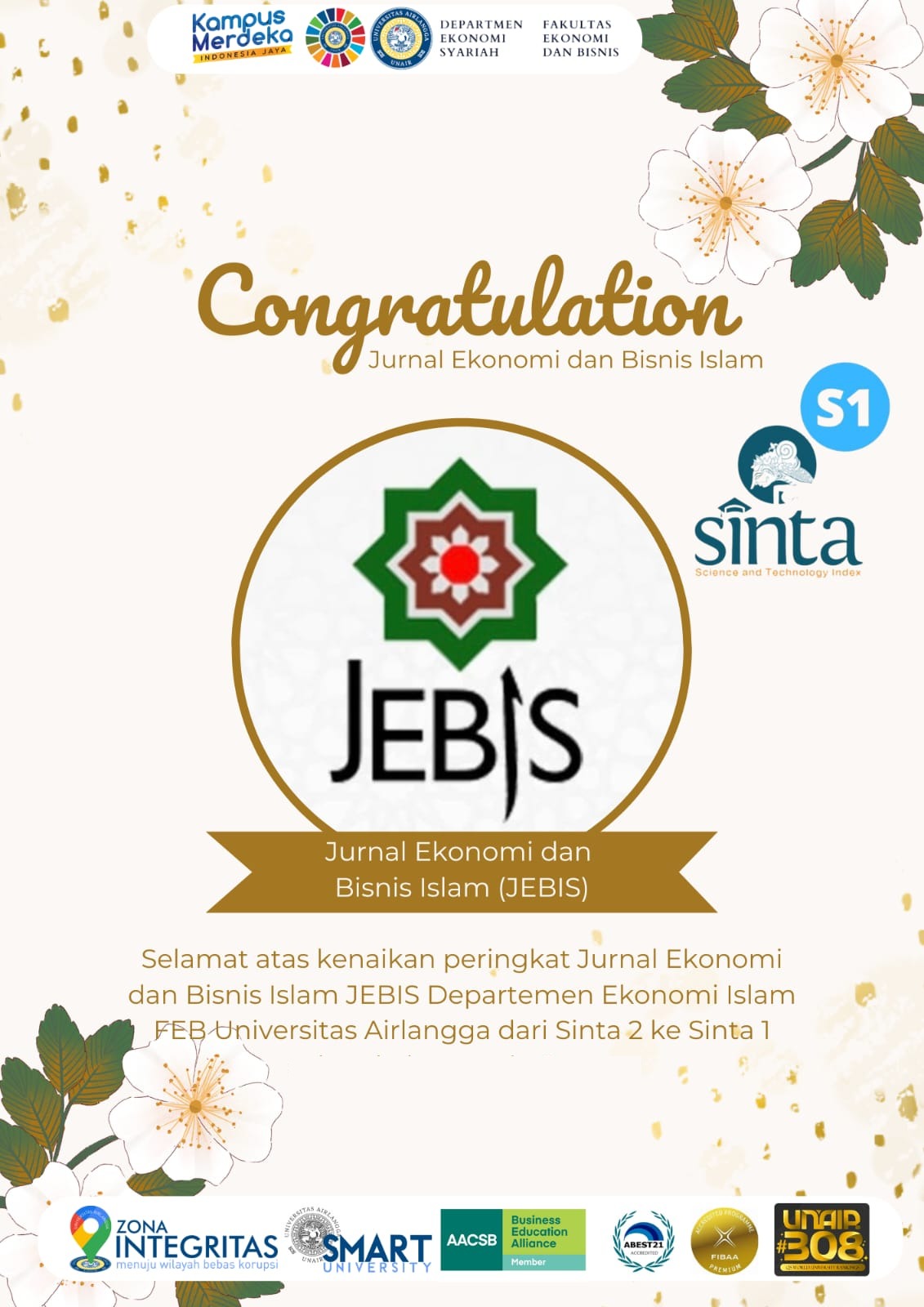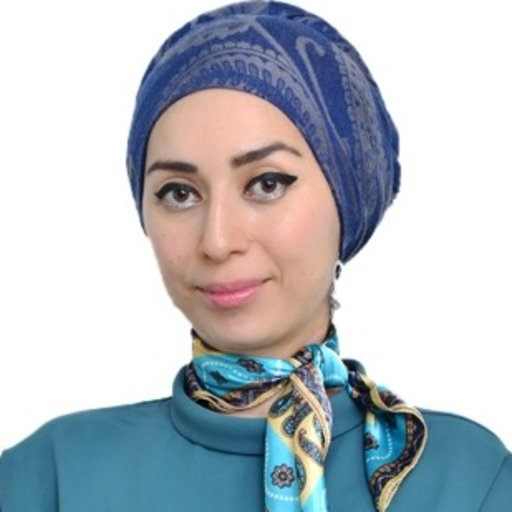THE IMPACT OF PRODUCTIVE AND CONSUMPTIVE FINANCINGS ON INDONESIAN ISLAMIC BANKING PROFITABILITY: MARKOV SWITCHING DYNAMIC REGRESSION
Downloads
This study investigates the effect of Islamic bank financings on banks' profitability during two distinct periods, namely stable and unstable conditions. This study also examines the profitability tendencies of banks during the two periods mentioned. To answer these objectives, this study applies the Markov Switching Dynamic Regression technique to 173 monthly observations from the Islamic commercial banking industry from December 2007 to March 2022. In stable times, the results indicate that productive financing harms the profitability of Islamic banks. Productive financing entails greater credit risk and can raise principal-agent concerns, moral hazard, and adverse selection. Consequently, productive financing necessitates higher monitoring costs. In an unstable period, consumptive financing negatively affects Islamic bank profitability. The proportion of consumptive financing exceeds the proportion of productive financing. This then increases the risk of credit and default, especially during economic instability when many consumers request reconditioning and even restructuring of financings from the bank. In addition, the results indicate that the profitability of Islamic banking is anticipated to endure longer in stable regimes and to recoup more quickly from unstable or crisis regimes. The findings of this study will likely serve as references and materials for banking management decisions, particularly financing decisions during periods of economic stability and crisis. Islamic banking should prioritize consumer financing during periods of economic stability and increase the proportion of productive financing during periods of economic instability.
Abdul-Rahman, A., Abdul Latif, R., Muda, R., & Abdullah, M. A. (2014). Failure and potential of profit-loss sharing contracts: A perspective of New Institutional, Economic (NIE) Theory. Pacific Basin Finance Journal, 28, 136–151. https://doi.org/10.1016/j.pacfin.2014.01.004
Ahmed, G. A. (2008). The Implication of using Profit and Loss Sharing Modes of Finance in the Banking System, with a Particular Reference to Equity Participation (Partnership) Method in Sudan. Humanomics, 24(3), 182–206.
Al-Mubarak, T., & Mohammad Osmani, N. (2012). Applications of Maqasid al-Shari'ah and Maslahah in Islamic Banking practices: An analysis Introduction. International Seminar on Islamic, October, 17. https://doi.org/10.13140/RG.2.1.3578.0644
Aliyu, S., Hassan, M. K., Mohd Yusof, R., & Naiimi, N. (2017). Islamic Banking Sustainability: A Review of Literature and Directions for Future Research. Emerging Markets Finance and Trade, 53(2), 440–470. https://doi.org/10.1080/1540496X.2016.1262761
Bougatef, K., Nakhli, M. S., & Mnari, O. (2020). The nexus between Islamic banking and industrial production: Empirical evidence from Malaysia. ISRA International Journal of Islamic Finance, 12(1), 103–114. https://doi.org/10.1108/IJIF-05-2018-0052
Chowdhury, M. A. F., Akbar, C. S., & Shoyeb, M. (2018). Nexus between risk sharing vs non-risk sharing financing and economic growth of Bangladesh: ARDL bound testing and continuous wavelet transform (CWT) approach. Managerial Finance, 44(6), 739–758. https://doi.org/10.1108/MF-12-2016-0371
Faradilla, C., Arfan, M., & Shabri, M. (2017). Pengaruh Pembiayaan Murabahah, Istishna, Ijarah, Mudharabah Dan Musyarakah Terhadap Profitabilitas Bank Umum Syariah Di Indonesia. Jurnal Megister Akuntansi, 6(3), 10–18.
Farihana, S., & Rahman, M. S. (2021). Can profit and loss sharing (PLS) financing instruments reduce the credit risk of Islamic banks? Empirical Economics, 61(3), 1397–1414. https://doi.org/10.1007/s00181-020-01912-5
Ghilal, R., & Maghfor, A. (2018). The financial crisis and its impact on comovements of financial markets: Evidence from exchange-traded funds. Journal of Economics and Business, 1(3), 242–259. https://doi.org/https://doi.org/10.31014/aior.1992.01.03.24
Hamilton, J. D. (1989). A New Approach to the Economic Analysis of Nonstationary Time Series and the Business Cycle. Econometrica, 57(2), 357–384. https://doi.org/https://doi.org/10.2307/1912559
Hamilton, J. D. (1990). ANALYSIS OF TIME SERIES SUBJECT TO CHANGES IN REGIME* James D. HAMILTON. 45, 39–70.
Ibrahim, E. D. A. B. (2006). The "missing links” between Islamic development objectives and the current practice of Islamic banking – the experience of the Sudanese Islamic banks (SIBs). Humanomics, 22(2), 55–66. https://doi.org/10.1108/08288660610669365
ihák, M., & Hesse, H. (2008). Islamic Banks and Financial Stability: An Empirical Analysis. In In IMF Working Paper.
Jayanto, P. Y., Kiswanto, N. A., & Mukhibad, H. (2017). An analysis on financial and social performance of Islamic banks in Indonesia. International Journal of Monetary Economics and Finance, 10(3/4), 295. https://doi.org/https://doi.org/10.1504/ijmef.2017.10008402
Khan, F. (2010). How "Islamic” is Islamic banking? Journal of Economic Behavior and Organization, 76(3), 805–820.
Klein, P. O., & Weill, L. (2018). Bank profitability and economic growth. The Quarterly Review of Economics and Finance, 84.
Lestari, R. S., & Anwar, S. (2020). The effect of mudharabah financing, musyarakah financing and profit Sharing Ratio On Profitability (ROA) with non performing financing as moderating variable. Islamic Accounting Journal, 1(2), 1–22.
Maikabara, A. A., Maulida, S., & Aderemi, A. M. (2020). Debt-based versus equity-based financing: a comparative analysis on efficiency of Islamic financial system. Journal of Islamic Economics, Finance, and Banking, 4(1), 1. https://doi.org/https://doi.org/10.12928/ijiefb.v4i1.3171
Masrizal, & Trianto, B. (2022). the Role of Pls Financing on Economic Growth: Indonesian Case. Journal of Islamic Monetary Economics and Finance, 8(1), 49–64. https://doi.org/10.21098/jimf.v8i1.1378
Mawardi, I. (2014). Pengaruh pembiayaan bagi hasil terhadap kinerja bisnis, kinerja sosial dan kemaslahatan Baitul Maal wa Tamwil di Jawa Timur. Universitas Airlangga.
Mawardi, I., Al Mustofa, M. U., Widiastuti, T., & Wahid, W. W. (2023). Early warning systems in Indonesian Islamic banks: A comparison of Islamic commercial and rural banks. Cogent Economics and Finance, 11(1), 0–21. https://doi.org/10.1080/23322039.2023.2172803
Miah, M. D., & Suzuki, Y. (2020). Murabaha syndrome of Islamic banks: a paradox or product of the system? Journal of Islamic Accounting and Business Research, 11(7), 1363–1378. https://doi.org/https://doi.org/10.1108/JIABR-05-2018-0067
Nomran, N. M., & Haron, R. (2022). Validity of zakat ratios as Islamic performance indicators in Islamic banking: a congeneric model and confirmatory factor analysis. ISRA International Journal of Islamic Finance, 14(1), 41–62. https://doi.org/https://doi.org/10.1108/IJIF-08-2018-0088
Nurfalah, I., & Rusydiana, A. S. (2021). the Regime Switching of Cycle Instability of Islamic Banking and the Economy: Evidence From Indonesia, Malaysia, and Pakistan. Journal of Islamic Monetary Economics and Finance, 7(2), 233–262. https://doi.org/10.21098/jimf.v7i2.1362
Nurfalah, I., Rusydiana, A. S., Laila, N., & Cahyono, E. F. (2018). Early Warning to Banking Crises in the Dual Financial System in Indonesia: The Markov Switching Approach. JKAU: Islamic Economics, 31(2), 135–156. https://doi.org/DOI:10.4197/Islec. 31-2.10
OJK. (2021). Snapshot Perbankan Syariah September 2021. Www.Ojk.Go.Id, 1–6.
Perwitasari, d ayu, Rustianawati, M., & Novita, L. (2020). Musharaka : Alternative financing solution in the pandemic of covid. Jurnal Ilmu Manajemen Advantage, 4(2), 64–69.
Salman, A., & Nawaz, H. (2018). Islamic financial system and conventional banking: A comparison. Arab Economic and Business Journal, 13(2), 155–167. https://doi.org/10.1016/j.aebj.2018.09.003
Sutrisno, S., & Widarjono, A. (2022). Is Profit–Loss-Sharing Financing Matter for Islamic Bank's Profitability? The Indonesian Case. Risks, 10(11), 1–12. https://doi.org/10.3390/risks10110207
Wahyudi, R., Diniyya, A. A., Satyarini, J. N. E., Mutmainah, L., & Maulida, S. (2020). The effect of debt-based financing and equity-based financing on Islamic banks profitability in Indonesia. International Journal of Islamic Business and Economics (IJIBEC), 4(2), 106–114. https://doi.org/https://doi.org/10.28918/ijibec.v4i2.2771
Wahyudi, R., Mujibatun, S., & Riduwan, R. (2019). Debt and equity-based financing, size and islamic banks profitability: empirical evidence from Indonesia. Jurnal Kajian Ekonomi Dan Bisnis, 12(2), 227. https://doi.org/https://doi.org/10.21043/iqtishadia.v12i2.3539
Warninda, T. D., Ekaputra, I. A., & Rokhim, R. (2019). Do Mudarabah and Musharakah financing impact Islamic Bank credit risk differently? Research in International Business and Finance, 49(March), 166–175. https://doi.org/10.1016/j.ribaf.2019.03.002
Yip, A. W.H., & Bocken, N. M. P. (2018). Sustainable business model archetypes for the banking industry. Journal of Cleaner Production, 174, 150–169. https://doi.org/10.1016/j.jclepro.2017.10.190
Yusof, E., & Fahmy, E. (2009). Munich Personal RePEc archive Islamic finance : Debt versus equity financing in the light of maqasid al-Shari'ah. Mpra.
Zulkhibri, M., & Sukmana, R. (2017). Financing Channels and Monetary Policy in a Dual Banking System: Evidence From Islamic Banks in Indonesia. Economic Notes: Review of Banking, Finance and Monetary Economics, 46(1), 117–143.

This work is licensed under a Creative Commons Attribution-NonCommercial-ShareAlike 4.0 International License.
- Every manuscript submitted to JEBIS must obey to the policy and terms set by Journal of Economics and Business Islamic.
- Publication rights on the contents of manuscript published by JEBIS is owned by JEBIS under consent and approval by the corresponding author(s).
- Full text of electronic publication of manuscripts can be accessed free if used for the purpose of education and research according to copyright regulation.
- Share ” copy and redistribute the material in any medium or format
- Adapt ” remix, transform, and build upon the material
- You must give appropriate credit, provide a link to the license, and indicate if changes were made. You may do so in any reasonable manner, but not in any way that suggests the licensor endorses you or your use.
- You may not use the material for commercial purposes.
- If you remix, transform, or build upon the material, you must distribute your contributions under the same license as the original.
Creative Commons Attribution-NonCommercial-ShareAlike 4.0 International License.





.png)














